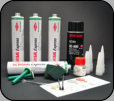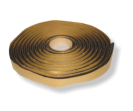

FAQ > DIY - Do It Yourself Auto Glass Questions
•
Can I buy a windshield and installation materials from Phoenix Glass to install it my self?
Yes
you
can,
but
if
it
bonds
to
the
vehicle
we
don't
recommend
it
for
many
reasons,
safety
being
the
key
one.
In
an
adhesive
bonded
windshield,
side
or
rear
back
glass
installation
for
example
there
are
many
items
and
steps
necessary
to
properly
install
them.
It
is
critically
important
that
a
proper
adhesive
system
be
used.
They
must
have
primers
used
on
the
pinchweld
and
possibly
the
glass
and
even
the
type
of
glass
cleaner
used
is
critical
to
the
safety
of
the
installation.
If
you
were
to
truly
purchase
all
of
the
components
that
are
necessary
to
properly
install
your
own
windshield
you
would
be
spending
much
more
of
your
hard
earned
money
than
you
would
if
you
had
your
windshield
professionally
installed
by
us.
You
also
would
be
avoiding
the
risk
involved
for
the
breakage
of
the
glass
if
something
went
wrong
and
you
would
have
a
warranty
for
the
product
as
well
as
the
workmanship.
We
have
actually
had
a
customer
that
went
through
5
windshields
before
he
final
caved
and
had
his
wife
bring
the
car
to
us
for
the
finale
6th
windshield
installation
so
the
bottom
line
is
we
highly
recommend
that
you
use
a
professional auto glass technician to install your windshield or other auto glass part.
In the paint work phase of the operation I-CAR states that
if
top
coats
are
being
applied,
masking
is
to
be
applied
over
the
primer
to
prevent
topcoats
from
being
sprayed
onto
the
surface
of
the
windshield pinchweld.
After
the
base
coat
and
clear
coat
have
been
applied,
the
masking
is
removed.
The
glass
pinchweld
should
be
cleaned
after
tape
removal to ensure any residual adhesive from the tape has been removed.
There
is
a
lot
more
to
be
said
to
answer
your
question.
The
pit
falls
in
doing
your
own
auto
body
repair
and
paint
work
are
tremendous
and way beyond the scope of this website.



There sure is! In the body work phase of the operation I-Car states that if body repair was completed on the pinchweld, it is
imperative that body filler not be used.
Windshields should never be installed over body filler.
•
My
car
had
a
tree
limb
fall
on
it.
The
limb
made
a
dent
in
the
roof
and
broke
my
windshield.
I'm
planning
on
doing
the
auto
body
repair
as
well
as
paint
work
myself
and
then
I
plan
on
having
Phoenix
Glass
install
my
windshield.
Is
there
any
special
body
or
paint
prep
work
I
need to do prior to the installation of the windshield?
•
10% of all accidents are vehicle roll overs which cause almost 11,000 annual fatalities.
•
The FMVSS 216 Standard says a roof must sustain no greater than a 5" crush when one and a half times the vehicle weight is
applied to the "A" pillar.
•
Vehicle occupants held inside the vehicle have a 25% greater chance of escaping injury.
•
75% of occupants ejected from their vehicles are fatalities.
•
Passenger air bags use your windshield for a backstop and can only function properly if the windshield remains in place during a
crash.
•
Click the link to see a Consumer Reports crash test video of your vehicle.
•
Should I use butyl tape to install my own (glue in type) windshield?
Absolutely
Not!
Butyl
Tape
is
a
sealant,
not
an
adhesive.
Back
in
the
day
when
butyl
was
used
it
provided
adequate
sealing
but
little
strength.
When
automobile
designs
changed,
adhesive
technology
improved
to
provide
high
structural
strength
as
well
as
a
moisture
seal.
Butyl
is
now
and
has
been
for
many
years
considered
a
contaminate and should be completely removed to ensure a 100% bond strength for the glass.



Auto
makers
didn't
make
the
transition
to
urethane
just
for
the
fun
or
economics
of
it.
Like
everything
else
in
life
they
learned
as
they
went
along
and
what
they
learned
from
all
the
data
they
collected
over
the
years
at
the
cost
of
serious
injures
and
loss
of
life
was
that
the vehicles they were producing had a serious short fall in the area of glass retention.
Safety studies show the most common cause of death is being thrown from a vehicle during an accident.
In 1970 federal legislation was enacted requiring the windshield to remain intact during a 30 mph frontal impact (FMVSS 212). In 1973,
a similar legislation was enacted requiring the passenger car roof to withstand roof collapse during a roll over accident (FMVSS 216).
Due to fuel economy and other concerns, automotive manufacturers choose not to reinforce the roof pillars to meet this standard.
The ANSI / AGRSS Standard
If
the
OEM
installation
was
butyl,
polysulfide,
or
other
non
polyurethane,
and
the
vehicle
is
licensed
for
highway
use,
adhesive
bonded
stationary
glass
installations
shall
be
performed
using
polyurethane
or
an
equivalent retention system unless in conflict with current OEM specifications
If
you
were
to
install
it
with
butyl
tape
and
your
vehicle
was
involved
in
a
severe
accident
it
will
allow
your
windshield
to
literally
pop
out
of
the
vehicle
allowing
the
passengers
to
be
ejected
from
within
it.
Today’s
auto
glass
isn't
just
designed
to
keep
the
elements
out
of
your
vehicle,
it's
a
major
part
that
is
designed
to
be
an
integral
part
of
the
vehicles
structure
and
it
must
be
installed
properly
with
an
adhesive
called
urethane.
Without
it
the
FMVSS
Specifications
the
vehicle
manufacturers
engineers
built
into
the
vehicle
are,
pardon
the
pun,
literally
out
the
window.
Actual
figures,
depending
on
whose
data
you
use,
say
that
butyl
tape
is
reported
to
have
a
holding
strength
of
60
psi
where
as
it's
reported
that
urethane
adhesive
has
a
holding
strength
of
600
psi.
Whomever
figures
you
use
it
still
comes
out
with
the
same
end
result
which
is
that
Butyl,
in
no
way,
has
anywhere
near
the
holding
strength
that
urethane
does.
Another
common
mistake
we
see
a
lot
is
people
buying
butyl
tape
off
the
auto
parts
store
shelf
without
the
compatible
primers
necessary
to
make
it
adhere
to
the
intended
surface.
Without
the
intended
pinchweld
and
glass
primers
not
to
mention
proper
compatible
paint
preparation
on
the
pinchweld
butyl
tape,
just
like
urethane,
won't
achieve
any
where
near
the
holding
strength
its
manufacturers intended it to. Even the type of glass cleaner used on an auto glass installation is critical.

Copyright 2013 © Phoenix Glass, Inc. All Rights Reserved
Revised June 2023
Please Like Us
on Facebook














